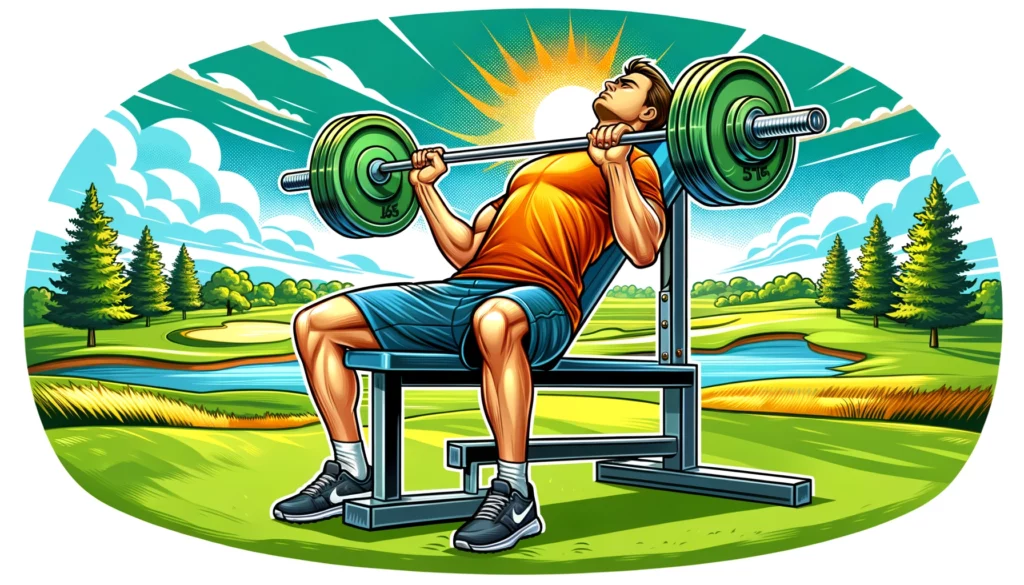Golfers, seasoned and novices alike, know that the game is more than just skill—it’s also about the power and control behind each swing. Strength training is not just for the athletes of high-contact sports; it’s a crucial component for anyone looking to improve their golf swing, increase shot distance, and elevate their game.
This post will delve into the why and how of strength training tailored for golfers, highlighting exercises to keep you swinging strong from the first tee to the last putt.
Strength Training for Golfers: Unlocking Your Full Potential

Understanding the mechanics of a powerful golf swing begins with strength training. Far from the misconception that it may hinder flexibility, a well-designed golf weight training program enhances the golf game by improving muscular strength and joint stability.
Let’s explore how to integrate weight training into your golf routine without skipping a beat.
The Golf Swing: Powering Up with Precision
Every golfer craves that perfect swing—the arc that’s both powerful and precise. Achieving this is a blend of technique and physical capability.
To increase club head speed and refine your swing, engaging in a targeted training program is essential. Here we’ll break down the exercises that contribute directly to swing improvement.
To amplify the precision and power of your golf swing, consider these exercises:
Rotational Cable Rows: Stand sideways to a cable machine, grasp the handle with both hands, and pull it towards your torso, rotating your body as you do. This motion mimics the rotation in a golf swing, building the muscles you use when you hit the ball. Perform 3 sets of 12 reps on each side.
Stability Ball Push-Ups: Assume a plank position with your feet on a stability ball. This exercise not only works your chest and triceps but also engages your core and improves your stability. Aim for 3 sets of 10 reps.
Golf Swings with Resistance Bands: Attach a resistance band to a low point, hold your golf club and perform your swing motion against the resistance. This helps build the specific muscles used in your swing. Practice 2 sets of 15 swings on each side.
Crafting a Golf Weight Training Program: From Tee to Green
A golf weight training program should be as much a part of your routine as practicing your putting. It’s about building strength where it counts without adding unnecessary bulk.
We’ll take you through a week-by-week guide, laying out a training schedule that complements the golfing season, whether it’s off-season or in full swing.
A comprehensive weight training program may include:
Deadlifts: Stand with feet shoulder-width apart, grip the barbell, keep your back straight, and lift by driving through the heels. It’s a full-body exercise that strengthens your posterior chain, crucial for a powerful swing. Perform 4 sets of 6-8 reps.
Shoulder Press: Either seated or standing, press dumbbells from shoulder height to above your head, which builds shoulder stability for your swing. Go for 3 sets of 8-10 reps.
Barbell Squats: With a barbell on your shoulders, squat down, keeping your knees slightly bent and back straight, then drive up through the heels. This exercise builds leg and core strength. Aim for 4 sets of 6-8 reps.

Core Muscles: The Engine of Your Swing
The core muscles are the engine of your golf swing, providing stability, power, and rotation. A strong core allows for a more powerful golf swing.
From plank positions to dynamic medicine ball twists, these core exercises will ensure your engine is running smoothly and efficiently.
Strengthen your core with these exercises:
Planks: Get into a forearm plank position, engage your core, keep your body in a straight line from head to heels, and hold the position for 1 minute. Repeat for 3 sets.
Medicine Ball Twists: Sit with knees bent and feet flat on the floor, hold a medicine ball with both hands, and rotate your torso from side to side. This move targets the obliques, which are essential for rotational swing power. Do 3 sets of 15 reps on each side.
Diagonal Medicine Ball Throws: Stand with feet shoulder-width apart, throw a medicine ball diagonally across your body against a wall or to a partner, engaging your core with each throw. Complete 3 sets of 10 throws on each side.
Upper Body: Sculpting Your Swing’s Architecture
A golfer’s upper body needs to maintain stability and control throughout the golf swing. This section will recommend upper body exercises that enhance strength in the arms, shoulder blades, and back muscles—ensuring your upper body can support and execute a precise swing every time.
Pull-Ups: Grip the pull-up bar with palms facing away from you and pull yourself up until your chin is over the bar. This exercise strengthens the back and arm muscles. Aim for 3 sets of as many reps as possible.
Bench Press: Lie on a bench, grip the barbell, lower it to your chest, and then press up. It’s excellent for building strength in the chest, shoulders, and triceps. Perform 4 sets of 6-8 reps.
Dumbbell Rows: Bend over a bench with one knee and one hand on it for support, row a dumbbell with the opposite arm, keeping your back straight. This will enhance the back muscles and grip strength. Do 3 sets of 12 reps on each side.
Maintain Stability and Drive: The Role of Lower Body Strength
Leg strength is often underestimated in golf. However, a stable lower body maintains your swing’s foundation. We’ll introduce exercises like single leg deadlifts and split squats to ensure your lower body provides the stability and drive needed for a more powerful swing.
Boost your lower body with these exercises:
Single Leg Deadlifts: Stand on one leg, lean forward with a straight back, extending the opposite leg behind you, and hold a dumbbell in the opposite hand. This exercise improves balance and strengthens the glutes and hamstrings. Complete 3 sets of 10 reps on each leg.
Split Squats: Place one foot forward and one foot back, lower your hips until the back knee is just above the ground, and then drive up through the front heel. This targets the quads, glutes, and improves stability. Perform 3 sets of 10 reps on each leg.
Leg Press: Sit in a leg press machine with your feet flat against the sled, press away with your legs, and then return to the starting position. It’s great for overall lower body strength. Aim for 3 sets of 10 reps.

Gym-Based Golf Strength Training Plan
Monday: Lower Body and Core Stability
Squats (4 sets of 6-8 reps): Focus on depth and form to build leg strength.
Deadlifts (4 sets of 6-8 reps): Enhance posterior chain strength for better swing support.
Leg Press (3 sets of 10 reps): Target the major muscle groups of the lower body.
Cable Woodchoppers (3 sets of 12 reps per side): For rotational core strength.
Hanging Leg Raises (3 sets of 10 reps): Improve lower core strength and stability.
Wednesday: Upper Body Strength
Bench Press (4 sets of 6-8 reps): Build chest and arm strength for a more controlled swing.
Lat Pull-Downs (4 sets of 10 reps): Strengthen back muscles for better swing posture.
Overhead Press (3 sets of 8 reps): Improve shoulder stability and power.
Bicep Curls (3 sets of 12 reps): For arm strength to support your golf grip.
Tricep Extensions (3 sets of 12 reps): Develop arm consistency throughout your swing.
Friday: Power and Mobility
Box Jumps (3 sets of 6 reps): Increase explosive power in the legs.
Medicine Ball Slams (3 sets of 8 reps): Develop upper body explosive strength.
Kettlebell Swings (3 sets of 15 reps): For hip power and core engagement.
Dumbbell Rotational Punches (3 sets of 10 reps per side): Mimic the golf swing for rotational power.
Dynamic Stretching Routine: Enhance flexibility and cool down.
At-Home Golf Workout Plan (Minimal Equipment)
Monday: Bodyweight Lower Body and Core
Bodyweight Squats (4 sets of 15 reps): Focus on form to build foundational leg strength.
Single-Leg Deadlifts (3 sets of 10 reps per leg): Balance and strengthen the hamstrings and glutes.
Plank Position (3 sets, hold for 1 minute): Core bracing and endurance.
Russian Twists (3 sets of 15 reps per side): With a household item for added resistance.
Wednesday: Upper Body and Stability
Push-Ups (4 sets of as many reps as possible): Upper body strength and endurance.
Dips using a chair or bench (3 sets of 10 reps): Tricep and shoulder strength.
Pike Push-Ups (3 sets of 8 reps): Shoulders and upper back focus.
Inverted Rows under a sturdy table (3 sets of 10 reps): Back and bicep strength.
Friday: Flexibility and Explosive Power
Jump Squats (3 sets of 10 reps): Build explosive leg strength.
Broad Jumps (3 sets of 6 reps): Power through the lower body.
Mountain Climbers (3 sets of 30 seconds): Core and cardio.
Dynamic Stretching and Yoga Poses: Focus on golf-specific movements to enhance flexibility.
At-Home Golf Workout Plan (With Resistance Bands)
Monday: Lower Body and Core
Resistance Band Squats (4 sets of 12 reps)
Banded Side Walks (3 sets of 15 reps per side)
Plank with Band Pulls (3 sets of 10 reps per side)
Seated Russian Twists with Band (3 sets of 15 reps per side)
Wednesday: Band-Assisted Upper Body
Band Pull-Aparts (4 sets of 15 reps)
Standing Band Press (3 sets of 12 reps)
Banded Push-Ups (3 sets of as many reps as possible)
Banded Bicep Curls (3 sets of 15 reps)
Friday: Power and Endurance
Banded Squat to Press (3 sets of 10 reps)
Standing Band Row (3 sets of 12 reps)
Band-Assisted Jump Squats (3 sets of 10 reps)
Cooldown with Band Stretches: Full-body stretch to maintain flexibility.
Each of these plans is designed to be repeated weekly, providing a balanced approach to building strength, stability, and power for the golf swing. Remember, it’s essential to start with a warm-up to prepare your muscles and joints for exercise and to conclude with a cool-down to prevent stiffness and aid in recovery.
Conclusion: Integrating Strength into Your Swing
Integrating strength training into your golf routine doesn’t have to be daunting. With the right guidance and exercises, you can improve your golf swing, gain more power, and reduce the risk of injury. Let’s put these elements into practice and watch as your golf game transforms.
Throughout this post, we will sprinkle in wisdom from certified personal trainers and insights from sports science to give you the confidence that your training program is backed by expertise. From Tiger Woods to the weekend warrior, strength training has a place in every golfer’s bag—just like the perfect club.
FAQs
How do you train for strength in golf?
Training for strength in golf requires a balanced approach that targets the muscles used in the golf swing. A golfer should focus on developing core stability, leg power, and upper body strength.
This includes exercises such as squats, deadlifts, rotational movements like woodchoppers, and stability exercises like planks. Incorporating a golf-specific strength training routine 2-3 times a week can significantly enhance the power and control needed for an effective swing. It’s not just about lifting heavy but also about increasing muscular endurance and maintaining flexibility.
What exercises increase golf swing speed?
To increase golf swing speed, exercises that build explosive power and fast-twitch muscle fibers are key. Plyometric workouts such as jump squats, medicine ball throws, and rotational power exercises like cable rotations or medicine ball twists can be very effective.
Training with resistance bands can also enhance swing speed by providing resistance through the golf swing motion, thus improving the relevant muscle groups. Consistency in these exercises, alongside technique work, can contribute to a noticeable increase in swing speed over time.
How do I get in shape for golf?
Getting in shape for golf means focusing on cardiovascular fitness, flexibility, strength, and balance. A mix of aerobic exercises like cycling or swimming helps build stamina for those long days on the course.
Flexibility can be improved with regular stretching or yoga, which also enhances balance. Strength training should be golf-specific, emphasizing core, leg, and upper body workouts. Finally, balance drills, such as standing on one foot or using a balance board, can improve stability in your swing.
How do you strengthen your arms for golf?
Strengthening your arms for golf involves targeting both the small and large muscles used in the golf swing. Incorporate exercises like bicep curls, tricep extensions, and wrist flexor and extensor movements.
It’s also beneficial to engage in compound exercises like push-ups, pull-ups, and dumbbell presses that simulate the golf swing and improve overall arm strength. Consistency and proper form are crucial to effectively build arm strength and avoid injury.
How do you build muscle for golf?

Building muscle for golf isn’t about bulk; it’s about creating lean, powerful muscle that enhances your swing without sacrificing flexibility. Key exercises include weighted squats, deadlifts for lower body strength, and bench presses and rows for upper body power.
Core exercises are vital and should be varied to hit different muscle groups. Remember, it’s important to complement muscle building with flexibility training to ensure a full range of motion in your golf swing.
Should golfers take creatine?
Creatine can be beneficial for golfers as it aids in increasing power and explosive strength, which can translate to a more powerful swing. It’s well-known for improving performance in short-duration, high-intensity activities, which is pertinent to the actions in golf.
However, it’s important for golfers to consult with a healthcare provider before starting any supplementation to ensure it aligns with their health needs and goals.
How do I get physically fit for golf?
Physical fitness for golf requires a mix of strength, endurance, flexibility, and balance. A well-rounded fitness regimen for golfers should include cardiovascular exercises for stamina, strength training for muscle development and power, flexibility exercises to maintain a full range of motion, and balance drills to improve body control.
Golfers should also consider working with a certified personal trainer, especially one with experience in sports-specific training for tailored advice.







